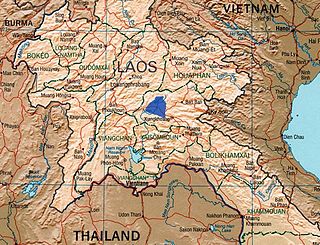Operation Junction City Jr.
On 28 July 1969, one company of Red Battalion was helicoptered in to Tang Vai on Route 111 and seized the airfield there with no opposition. As Tang Vai lay 31 kilometers from friendly forces, on the edge of the Ho Chi Minh Trail, the lack of opposition was surprising. The next day, a battalion of the Royal Lao Army was flown in. On 2 August, Green Battalion was also helilifted in, they moved out east under an umbrella of air support from both the USAF and the Royal Lao Air Force (RLAF). When they struck Route 111, Red Battalion headed northeast toward the communist positions at Muong Phine. Green Battalion moved southwards, then turned to the east. [7] Arrangements were made for RLAF T-28s and U.S. Air Force A-1E Skyraiders to fly air cover for the Royalist forces, amassing only 200 sorties in the month between 28 July and 28 August. [8]
On 28 August, the offensive operation was extended, with the aim of occupying Moung Phine for a week and blocking the intersection of Routes 9 and 23 nine kilometers west of the town. As Moung Phine was the only Pathet Lao-held town in the Laotian panhandle, and served as a communist sanctuary, it was a prime target because it had been off limits to air strikes. The renewed operation was facetiously dubbed Junction City Jr. after both the 1967 operation in South Vietnam and the road junction objective. [9]
White Battalion was now lifted into Vang Tai. While it marched east to join Green battalion, Bataillon Commando 203 (BC 203) was airlifted in by RLAF Sikorsky H-34s to secure Vang Tai and its airstrip while White and Green Battalions moved toward the road intersection. As of 1 September 1969, air support was limited to 12 A-1 sorties daily, supported by a flareship by night and two forward air controllers (FACs) by day. On 2 September, Red Battalion was halted when it took 17 casualties in a brief clash with the communists. That same day, Green and White Battalions were halted by high water in the Se Thamouak River. Forcing a crossing two days later, they peacefully occupied the 9/23 intersection. On 6 September, Red Battalion joined them. At this point, the Rules of Engagement were changed to allow air strikes on Moung Phine. [8] [10] [11]
USAF fighter-bombers seeded all routes into Moung Phine with Mk-36 area denial ordnance to block traffic—Routes 9, 23, and the combined 9/23. Early on 7 September, four USAF A-1E Skyraiders bombed the town; that afternoon, four more repeated the attack. That evening, the Royalist irregulars took Moung Phine. They captured 45 Pathet Lao soldiers, freed 165 detained Lao citizens from various jails and another 2,000 villagers from porterage. A cache of 2,000 small arms and copious documentation were also captured. [10] In all, 2,000 tons of supplies were captured, and 1,500 villagers evacuated to government territory. [12]
At this point, there was a controversy over whether to spray herbicide on standing rice crops around Moung Phine to deny them to the communists. Given the increasing communist antiaircraft weaponry opposing them, the need for rice to feed local populace, and fear of communist counterattacks in reprisal, only ten percent of the crops were sprayed. [13]
Based on success to date, the decision was made to once again extend the offensive. The objective now became cutting the Ho Chi Minh Trail near the transshipment point of Tchepone. [14] Tchepone was garrisoned by six PAVN battalions defended by antiaircraft guns. Air support for the government forces would come from the numerous tactical air sorties already directed at the Trail, and would be directed by Nail FACs and Raven FACs. Although the Royalists realized that capturing the actual town was unlikely, they planned to occupy another road junction, Routes 9/91 ten kilometers northwest of Tchepone. They also planned to cut Route 9 between Tchepone and Vietnam, stranding the North Vietnamese garrison. However, they paused to refresh and realign their forces. [10] [11]
On 13 September 1969, BC 203 moved forward to garrison Moung Phine. On 17 September, White Battalion was withdrawn from the operation, to be replaced by Yellow Battalion. By 23 September, Yellow Battalion occupied a mountaintop position overlooking Moung Phine. Green and Red Battalions were then withdrawn by 28 September. On 29 September, Blue Battalion replaced them. [15]
Blue Battalion marched toward the 9/91 intersection and occupied the intermediate junction of Routes 9/914, five kilometers short of 9/91. A PAVN counterattack pushed Blue Battalion southwestward into defensive positions on a nearby mountain. [16]
On 4 October, an approaching crowd of refugees was mistaken for PAVN by BC 203; the Royalist regulars fled to Moung Phalan. [16] Nearby Yellow Battalion followed suit, abandoning its hilltop stronghold. Early on 6 October, not knowing Moung Phine had been abandoned, a company from Red Battalion was airlifted into an ambush on the airstrip. Two 20th SOS helicopters were downed on the runway, stranding eight USAF fliers and 44 Lao troops. Scavenging four M60 machine guns from the crashed helicopters to beef up their defense, the fliers and the Red Battalion soldiers held off the PAVN all day. After being reduced to using sidearms for defense, the surrounded detachment was rescued at 18:30 by two helicopters swooping in under cover of an airdropped tear gas barrage. [17] [18]
Green, White, and Blue Battalions staged an eastward assault from Muong Phalane toward Moung Phine, while Red Battalion moved toward the 9/914 junction. By 17 October, the three battalion attack force had stalled six kilometers shy of the 9/23 intersection. Lacking both an overall operational commander to coordinate maneuvers, as well as support from CIA handlers distracted by Kou Kiet, the operation was terminated. The communists had regained all their lost ground. [18] [19]
